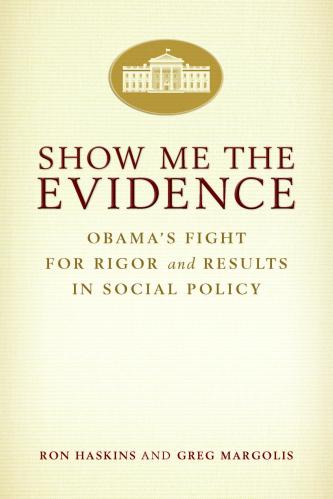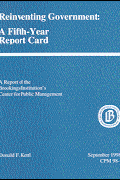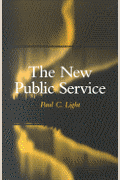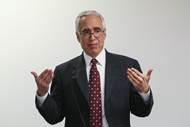George W. Bush is almost sure to break the presidential record for the fastest cabinet shake-up in history. Every second-term president in history has made cabinet changes, if only to put fresh tires on the administration. But with six secretaries gone in two weeks and more resignations sure to come, Bush has already bested Jimmy Carter, who replaced five secretaries during his 1979 “midsummer massacre,” and will easily best Bill Clinton, who replaced seven secretaries in the two months following his 1996 reelection.
Bush is moving fast for a reason. Despite all the mandate-making in the White House, the long shadow of 2008 will soon appear on the political horizon.
Bush has a year at most to set the national agenda, and a year at most beyond that to get it enacted. History suggests that anything left on the table after the midterm congressional elections is likely to languish until the end of the term.
It is far better to fell the cabinet in a single stroke than allow the comings and goings to drag into the first 100 days of his second term.
Bush also understands that the cabinet will become more important as his political capital dwindles. Like the second-term presidents before him, Bush will inevitably turn to the largely hidden levers of power that reside deep in the federal bureaucracy, using the administrative presidency for solace as public interest fades.
The sooner he replaces his cabinet, the sooner he can replace replace the hundreds of lower-level appointees who will leave with their bosses, and the sooner these replacement can learn their jobs.
Bush’s choices clearly reveal changes in attitude, but not changes in latitude.
The trades are easy to describe: Condoleezza Rice’s unquestioned loyalty for Colin Powell’s potential dissent, Alberto Gonzalez’s quiet commitment for John Ashcroft’s polarizing intensity, and Margaret Spellings’ expertise for Rodney Paige’s disdain for detail. Having drafted much of the policy they will now implement, Rice, Gonzalez, Spellings and the other White House loyalists who are moving out, have no misgivings about the Bush agenda, which is exactly why they have been selected.
All cabinet posts are not created equal, however. Some of the new Bush appointees will be just as invisible as their predecessors, while others such as Gonzalez and Rice rarely will be far from the headlines. Some will simply follow orders, while others will continue to shape the agenda through close ties to the White House. Some will have no other directive than to first do no harm, while others will be asked to defend the president’s agenda at all costs.
Whatever their particular role, the new cabinet will share the president’s three broad goals for governing in the second term.
First, the Bush administration intends to speak with one voice. The president has never enjoyed the kind of give and take that animated the Clinton administration day and night, nor has he expressed much interest in the kind of devil’s advocacy that might have uncovered some of the surprises that the United States now faces in Iraq.
For good or ill, Bush is a president who knows exactly where he wants to go. His cabinet members will either follow him or be replaced.
Second, the Bush administration is working closely with the Republican Congress to mute at least some of the Constitution’s traditional checks and balances. Hence, last week’s effort to tighten Senate procedures to make the normally-unruly chamber more like the House, and the parallel effort to make the tightly-controlled House even more disciplined.
With the Cabinet under tight White House control and the taming of the Senate underway, the Bush administration may yet be able to implement a corporate model of governing in which the president is not just the chief executive officer of the federal bureaucracy, but the chairman of the lawmaking process on Capitol Hill as well.
Third, the Bush administration intends to use every last ounce of federal largesse and patronage to create a lasting Republican majority at both ends of Pennsylvania Avenue. The Bush administration rarely missed an opportunity to target federal funding to swing districts in the first term, but will be even more astute in the second term.
Although much of the targeting falls to lower-level political appointees who work closely with the White House political operation headed by Karl Rove, the Cabinet secretaries must be ready and willing to do their part in both endorsing and promoting the president’s program. The new Cabinet cannot give George W. Bush a third term, but it can create at least some of the conditions that assure future Republican success.
Even a carefully planned shake-up is no guarantee of success, however. Wars go bad, oil prices rise, economies sour, new appointees often have hidden agendas and the federal bureaucracy often resists. If a shake-up was a political silver bullet, Jimmy Carter would have won a second term and Bill Clinton would not have been impeached.
Moreover, Cabinet officers have responsibilities to their departments and the public as a whole. There are no Red States or Blue States when it comes time to building an effective Department of Homeland Security, for example, and even loyal White House lieutenants can be captured by their departments.
But Cabinet members do make choices about where to spend their time and energy, how tightly to govern their departments, where to intervene in the exercise of power and whom to support when disagreements arise.
This power to decide what to decide is why so many observers were troubled by the recent memo from the new head of the Central Intelligence Agency, Porter Goss, urging employees to “support the administration and its policies in our work,” and why some worry that there might be too much control from 1600 Pennsylvania Avenue.
Cabinet members are also the object of extraordinary attention, particularly from the legions of lobbyists and supplicants who curry favor with everything from Super Bowl tickets to luxury junkets. Like the power to decide, this attention can create the appearance, and occasional outright presence of conflicts of interest, which is why so many Americans have come to doubt their government’s honesty. If there is any risk in changing so many Cabinet posts at once, it is in the skeletons that may yet be found in a new secretary’s closet.
The Constitution gives cabinet members a simple instruction in dealing with this combination of power and perquisites. No matter what else they are asked to do, their first responsibility is to help the president faithfully execute the laws.
If and when this Constitution directive conflicts with politics, legacies or loyalty, cabinet members must always choose the Constitution first. The new Bush cabinet can be no different.
The Brookings Institution is committed to quality, independence, and impact.
We are supported by a diverse array of funders. In line with our values and policies, each Brookings publication represents the sole views of its author(s).








Commentary
Op-edBush’s New Cabinet: Changes in Attitude
November 21, 2004